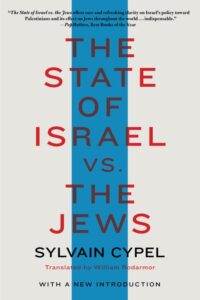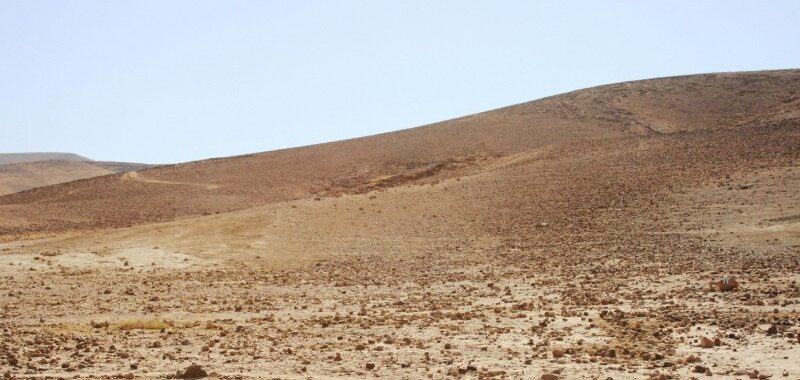The date was July 3, 2012. Over the previous few months, a series of violent attacks had been launched against certain refugees, most of them from Sudan and in particular from Darfur, with its terribly repressive regime, and Eritrea, where the authorities’ death squads had unleashed a reign of terror. In Israel, voices were increasingly being raised against the presence of undocumented aliens, which they called “infiltrators.” The choice of name is no accident. In the 1950s, “infiltrators” is what Palestinians expelled between 1947 and 1950 were called when they tried to come back to see what had happened to their village and their possessions. “Infiltrator” was the equivalent of “terrorist.”
Article continues after advertisement
On that day in 2012, the Netanyahu government’s interior minister, Eli Yishai of Shas (ultra-Orthodox Sephardic), gave an interview to the newspaper Maariv. “Most of those people coming here are Muslims who think the country doesn’t belong to us, the white man,” he said. “I will continue the struggle until the end of my term, with no compromises.” He said he would use “all the tools to expel the foreigners, until not one infiltrator remains.”
*
Yishai’s statements are interesting for several reasons. First, because they were made in a supposedly democratic country by an interior minister who had earlier sided with the racist rioters against the victims. Second, because they reveal his ignorance: Eritreans (about 72 percent of the undocumented Africans in Israel) are more usually Christian than Muslim, and like the Sudanese (20 percent), include many animists. Finally, and especially, because the undocumented aliens the minister hoped to expel were Black.
This involved 40,000 people among the 180,000 to 200,000 immigrants then in Israel, most of them Asian or Eastern European, and most of whom were also undocumented. Undocumented immigrants from countries other than Black Africa often work in construction or as farm labor, and are regularly underpaid and denied social rights in Israel, where associations defending them protest their mistreatment. But unlike Africans, they have never faced calls for their mass expulsion.
Xenophobic and racist talk exploded, both in the media and on the street.
We are witnessing a phenomenon unprecedented in Israel. Up to now, anti-Black racism has been virtually nonexistent. And Israel’s putting itself under a banner defending “the white man” is foreign to Zionism’s ideology and history. Defense of the West? Sure, but of the white man? You would search in vain for such a reference in Zionism’s foundational texts and the historic debates in Israel. So this is something new. Is it anecdotal or significant? It’s true that the Black Israelites who began to arrive from New York in the 1970s had trouble integrating. They were mainly settled in “developing” cities—meaning poor and distant—in the Negev desert.
The Ethiopian Jews, who were once known as Falashas and who were recognized as Jewish by the Israeli rabbinate in 1974, came in two great waves between 1984 in 1994, and today number more than 100,000. Though Jews, they continue to be harshly discriminated against at times, especially in housing, and remain confined to particular neighborhoods with high unemployment rates. Some mayors refuse to enroll the migrants’ children in schools. But a few Ethiopian Jews have found spectacular success, especially in sports and show business, and several have become members of the Knesset. So their integration has been problematic, but nowhere near as hard as that of refugees from East Africa, who soon became the target of radical hostility.
The first such refugees began to arrive in the second half of the 2000s. The flow accelerated in 2011 and 2012. They very quickly congregated in three southern Tel Aviv neighborhoods: Shapira, Hatikva, and Neve Sha’anan. At first, the government took steps it hoped would discourage them. A special immigration police was created to manage them and keep them from coming. In 2010, the government launched a project to build a wall along the border with Egypt to keep them out.
In addition, when these immigrants find work, their employers are supposed to deduct 20 percent of their wages and give it to the government, to provide the funds necessary for future expulsions. As for requests for asylum, of 15,205 applications made to the Interior Ministry between 2013 and 2018, only eleven—about 0.07 percent—were granted. By comparison, in the European Union at the same time, requests for asylum were granted to 57 percent of Sudanese, and 92 percent of Eritreans.
The first actions against the immigrants’ presence soon began. Settlers in Hebron vented their hostility on the ones in their neighborhoods. Racial attacks multiplied. Municipalities like Kiryat Shalom passed laws that stipulated that no private apartment, and not even a room, could be rented to one. Eliat’s city hall rejected Black children in its schools. In Tel Aviv, separate kindergartens were created for them.
Writing in the Washington Post, journalist Gershom Gorenberg described meeting Emanuel Yamani, an Eritrean refugee to whom an Israeli policeman had once said: “Soon we’ll deport all of you. You can go sit under a tree, open your mouth, and wait for a banana to fall into it, like monkeys.” When Yamani answered that he was a human being, the amused policeman said, “Haven’t you looked at yourself? Don’t you see you look like a monkey?” Gorenberg asked the Interior and Immigration ministries for their reaction, but got no response. Everyday racism was spreading, winked at by public authorities.
Netanyahu noticed the shift in the wind. “If we don’t stop the problem,” he said in 2012, “60,000 infiltrators are liable to become 600,000 and cause the negation of the State of Israel as a Jewish and democratic state.” This led to a series of similar statements, each more alarming than the rest. In May 2012, several violent attacks were made against places where Africans gathered, including a clinic for refugee children, which was torched. Miri Regev, the future culture minister, agitated to have the immigrants deported. Lashing out at the “leftists” (several Labor members had taken up the African refugees’ cause), she declared that Sudanese infiltrators were “a cancer in the nation’s body.” When they responded with outrage, Regev apologized for the comparison…to the cancer sufferers! From then on, xenophobic and racist talk exploded, both in the media and on the street.
Hatred for the Black immigrants joined hatred for the “beautiful souls” who supported them.
Likud member Danny Danon said, “We must expel the infiltrators from Israel. We should not be afraid to say the words ‘expulsion now.’” Danon would go on to become minister of science and technology, then Israel’s ambassador to the United Nations. Member Yulia Shamalov-Berkovich said that lawyers assisting asylum seekers should be interned with them in the detention camps.
In December 2013, the government began a policy of “voluntary departures” for these immigrants, in exchange for a small payoff. NGOs supporting them protested, pointing to the history of the Wandering Jew and to Hillel the Elder’s edict: “That which is hateful to you, do not do to your fellow. That is the whole Torah.” But Netanyahu, riding a wave of popular support, persisted. Immigrants were interned in camps in the Negev and deprived of their papers.
Saimon Fisaha, an Eritrean who had lived and worked in Israel for six years, wound up in the Holot camp. There, he was offered $3,500 and a one-way ticket to Rwanda. He was assured that when he arrived, he could ask for asylum and find work. Three days later, he was on a plane with ten fellow refugees. Writing in the New Republic, Brian Goldstone described what happened next. On arrival in Kigali, Fisaha had to hand over his identity papers. When he asked how to begin the asylum request process, the agent said it couldn’t be done and refused to return Fisaha’s papers unless he paid him $500 and left the country.
Fisaha and the others had fallen into the world of human trafficking. He would wind up traveling to the Mediterranean through Sudan and Libya, experiencing “beatings and imprisonment, theft and extortion, extreme hunger and dehydration, [and] the threat of deportation back to Eritrea”—in other words, possible death. Held captive in Libya under dreadful conditions, he witnessed the enslavement of men and women, rape, and torture. Fisaha finally reached Europe on a leaky boat carrying three hundred people like him.
On January 3, 2018, Netanyahu launched a major new policy he claimed would “resolve” the problem of African asylum seekers. “The government approved a plan today that will give every infiltrator two options: a plane ticket out or jail.” Refugees would be offered $3,500 in cash, plus repayment of the money deducted from their pay if they had been working (20 to 40 percent of their wages). Refusal would be punished by incarceration in the high-security Saharonim detention center in the desert (with no exemption for the five thousand children born in Israel to African couples). Israel claimed to have signed agreements with Uganda and Rwanda to welcome the deportees, but the two countries denied such an agreement existed. Accounts of the fate experienced by refugees flown to Rwanda began to spread, and they sounded like what Fisaha had experienced. Amnesty International published a damning report that said that those who arrived hadn’t been offered refugee status, residency visas, or jobs.
Soon 750 asylum seekers at the Holot camp began a hunger strike. In late February 2018, 20,000 people demonstrated in Neve Sha’anan in support of the refugees. But polls showed that two-thirds of the Israeli public still supported their mass expulsion. And hatred for the Black immigrants joined hatred for the “beautiful souls” who supported them: intellectuals, artists, and NGO militants. It was similar to the way some Trump supporters hate the people who support Blacks and immigrants in the United States.
In March 2018, hundreds of additional refugees were interned in the Negev. On April 2, Netanyahu announced a dramatic reversal: Israel had reached the “best possible agreement” with the United Nations High Commissioner for Refugees, he said. The U.N. agency would take charge of settling half of the refugees in countries like Germany and Canada; the other half would receive residency permits in Israel. A huge outcry against the government erupted. Naftali Bennett, the minister of education and the head of the religious extreme right, blasted an agreement he said offered “paradise for infiltrators.” Three hours later, Netanyahu said he would “reexamine” the accord. Back to square one.
At the height of the Mediterranean refugee crisis, the Pew Research Center published the result of a poll taken in eighteen of the thirty-six member countries of the Organization for Economic Cooperation and Development (OECD). The question asked was, “Would you take refugees from countries where people are fleeing violence and war?” Israel emerged as the country most hostile to welcoming refugees, with 57 percent of respondents saying no. Hungary was the second most hostile, with 54 percent. (In thirteen of the eighteen countries, majorities said yes.) The admonition in Exodus 22:21—“You must not exploit or oppress the foreigner, for you yourselves were foreigners in the land of Egypt”—seems the one least embraced in the nation-state of the Jewish people.
__________________________________

From The State of Israel vs. the Jews by Sylvain Cypel, translated by William Rodarmor. Copyright © 2024. Available from Other Press.

